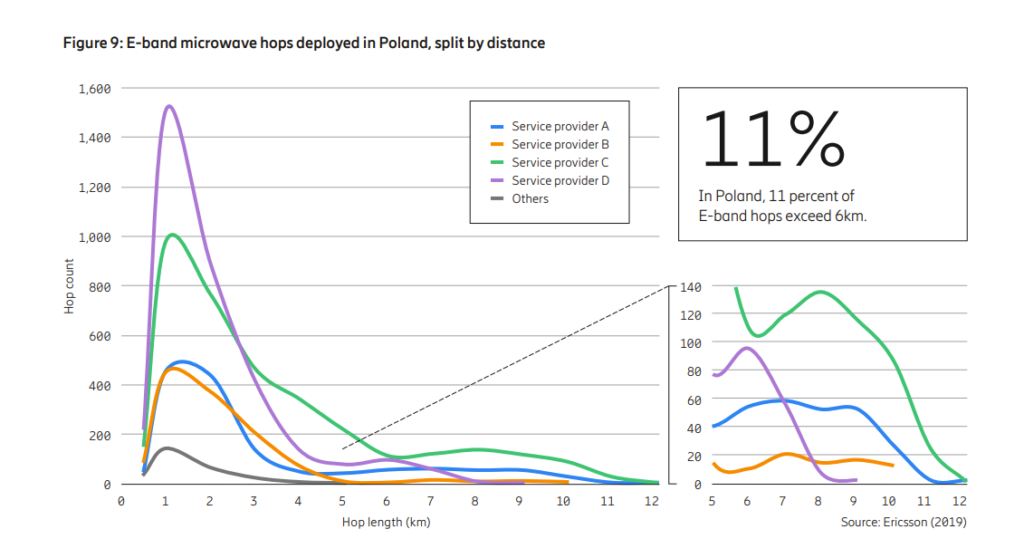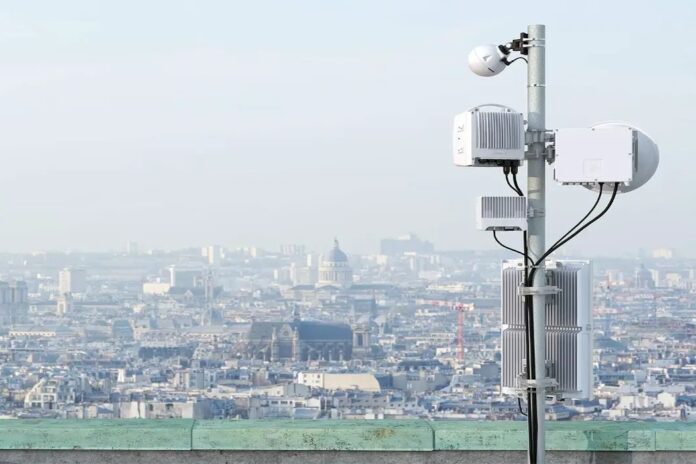E-band can fulfil the backhaul needs of most 5G networks beyond 2030 as innovation and multiband overcome the spectrum’s shortfalls
Despite mobile operators spreading their fibre footprints globally, Ericsson is forecasting a 50/50 split between microwave and fibre for mobile backhaul by 2030, when 6G is expected to start arriving.
In its Microwave Outlook 2023 report, the vendor said that E-band spectrum (71-86GHz) can meet the backhaul capacity needs of most 5G sites up to 2030 and beyond, being already open for deployment in countries where 90% of the world’s population live.
E-Band is a high-density, short wavelength frequency range that is increasingly used for microwave backhaul links of around 3km, due to its directional properties afforded by the short wavelengths.
Since 2021 a further 20 countries, notably China and India, have opened up E-Band, which can deliver high backhaul capacities in 5G networks thanks to its large amount of spectrum, which provides wide channels.
While traditional microwave bands still play a role because they can cover longer distances with fewer hops, their smaller channel sizes – typically up to 224MHz – present a challenge for supporting several 5G use-cases, such as Enhanced Mobile Broadband, which require throughputs of more than 8Gbps.
Ericsson acting head of microwave systems, business area networks, Mikael Öhberg told Mobile Europe the report also flags recent innovations that are helping to overcome some of E-band’s disadvantages like the fact it is less useful for long-range signal transmission, without very high-power systems, due to significant attenuation caused by atmospheric gasses absorbing its signals.
Densifying networks
Ericsson decided to simulate E-Band use in three European cities with different topologies to see if it could meet future traffic demands as 5G networks evolve and become increasingly capable and densified.
The links ranged from 300-1,000 and it was assumed that 10x500MHz channels were available. The models also demonstrated a mix of other microwave and fibre backhaul in use with the E-band.
More than 80% of all the E-band links can achieve 44Gbps (corresponding to using all 10 of the 500MHz channels) for a sparse network that has 20% of its links using E-band. An extreme network that uses E-band for all links can achieve 44Gbps for more than 50% of its links.
Ericsson concluded that there was only some extreme deployments, like dense hubs, that can experience congestion, and will therefore be the first to need alternative backhaul solutions as the demand for capacity grows.
“Predicted backhaul capacity figures for the most advanced urban distributed RAN sites by 2027 are around 25 Gbps – but these extreme capacities would only be needed by a few advanced sites,” stated the report, adding that E-band can provide sufficient backhaul capacity for many years to come.
Öhberg said the key limitation for E-band will be how much of it the world’s regulators open up. “90% of the world’s population live in countries where E-band is open for deployment,” he said. “The E-band spectrum is predominantly licensed, but many countries also use a light licensing regime and/or low spectrum fees to encourage the use of this band.”
Service providers clearly want to continue using licensed spectrum instead of unlicensed spectrum [like] V-band (57-71GHz), to guarantee performance,” he told Mobile Europe.
While many countries classify V-band as unlicensed spectrum, only a few countries retain it for licensed or defence use. In the US, it is used for WiGig (based on the 802.11ad wi-fi standard). As always, non-exclusive use of the spectrum makes links susceptible to interference. It also suffers from higher oxygen attenuation that severely limits the hop lengths.
Overcoming E-band’s limitations
Band and carrier aggregation (BCA) is one technique to increase the distance of point-to-point links while at the same time providing better reliability. Combining lower bands such as 15, 18, or 23GHz with E-band using dual-band antennas can enable links to cover 7-10km with capacities that can exceed 10Gbps.
Öhberg said several service providers have shared their strategy to use E-band in its previous reports. What is common among them all is that they will use E-band for longer hop distances and often in multiband configurations.
This means using radios with built-in carrier aggregation, or symmetric power splitters, to combine two radios on one antenna polarisation. “[In the 2021 report], Telefónica Germany [planned] a massive deployment of E-band systems in the run-up to 2025, to address the roughly 60% year-on-year traffic growth,” he said.
“The overall E-band network share, compared to traditional microwave systems, will increase from 1% as of [2021] to 20% by 2025,” he said. “Longer link lengths, from 3-10km, will be deployed as multiband systems. Telefónica Germany plans to move all microwave systems to a capacity larger than 2Gbps by 2025. This will be achieved by using a mix of 112MHz, 224MHz, E-band and D-band.”
He also used the example of Poland’s use of E-band from Ericsson’s 2019 report (below) where 11% of links exceeded 6km.

“When Ericsson uses the term carrier aggregation in the context of microwave, it is when a radio supports two different channels simultaneously, instead of only one,” he said. “You double the capacity with the same tower footprint as the radio with one channel. This is an efficient tool when wider channels are not available.”
In dense urban areas, Öhberg said E-band will often be used as a standalone solution since the distances between mobile sites are short. In suburban and rural areas, it will often be used in multiband which he said minimises the number of antennas, while reducing weight and space occupied on the mast. Common muti-band combinations are: 13/80, 15/80, 18/80, 23/80, 28/80 and 32/80GHz.
Easy for you to sway
Compact high-gain E-band antennas focus the signal into a narrow beam, but with greater focus comes a higher risk of misalignment that puts tougher requirements on the stability of the mounting structure – in particular, the impact of wind and thermal deformation.
Öhberg said such mast sway can be neutralised by a sway compensation antenna. This is similar to a conventional reflector antenna with the ability to detect misalignment and adapt the beam direction to keep the highest possible gain pointing towards the far end.
The report cites a 10Gbps E-band link – subject to sway – where only 0.3m reflectors, or smaller, can be used. The maximal distance of this link with 99.9% availability is 3.8km. By eliminating sway, a 0.6m antenna can be used without problem and the maximal link distance becomes 4.9km, an increase of about 30%.
Stabilisation algorithms enable use of even larger antennas: A 0.9m antenna gives a maximal distance of 7km, which is an 80% increase compared to distance achieved by a 0.3m antenna without sway compensation.
Rain repeat and fade
At E-band frequencies, rain attenuation is a big problem but Öhberg said multiband is an efficient way mitigate this. “By combining a lower-frequency band that has good propagation properties with a higher-frequency band that has broader channels and more capacity (such as E-band), it is possible to achieve high capacities over longer distances with increased availability,” he said.
“By applying some flexibility both up and down on the availability target for the traditional band, it can be seen that the most relevant bands to combine with 70/80GHz are 18–28GHz in mild climate, and 15–23GHz in severe climate,” he added.
“However, there is an impact on link ranges for E-band with regards to rain zone, both as stand-alone and multiband since the availability for the same capacity will decrease when increasing the rain intensity for the same distance meaning link distances will most often be shorter in the tropics compared to, for example, the Nordic countries,” he said. “But the uptake of E-band in India is a good proof point that it is also applicable for tropical environments.”
Lineox reduces opex with AI
The report highlighted how Spanish service provider Lineox is using AI-based network automation to reduce site visits by 40% by using automatic scripts. Lineox is a neutral broadband operator using 100% radio link technology. To ensure connectivity throughout its entire territory, Lineox owns a network of more than 10,000 radio links, used mainly to transport telecom traffic.
Before May 2022, 50% of all microwave-related tickets raised resulted in a site visit. Site visits dropped by 40% after June 2022, when Lineox introduced automated alarm filtering on top of its network manager.
Although the total number of tickets increased, as the tool was able to detect network issues that had previously been missed or neglected, the number of actual work orders issued was reduced as the tool helped the service provider to prioritize whether a work order needed to be opened or if the network impact was negligible so that no action was needed.
Öhberg said AI enables service providers to create an effective preventive maintenance program to avoid expensive emergency site visits. Moreover, it will also make it possible for service providers to add new use cases such as propagation event classification, hardware degradation, radio deep sleep optimisation and network traffic prediction.
The role of 26-28GHz in mobile backhaul
At the World Radiocommunication Conference 2019, a global IMT (5G) identification was decided for the high bands: 26GHz (24.25–27.5GHz), 40GHz (37–43.5GHz) and 66–71GHz. As a result, usage of backhaul will eventually be transitioned from some of these bands, such as 26GHz in Europe.
The timing of the transition will vary between countries, depending on the demand for 5G NR balanced against the importance of existing backhaul.
“In Europe, the 26GHz band (24.25–27.5GHz) is the pioneering mmWave 5G NR band. However, it is expected that some countries will release 26.5–27.5GHz first, partly due to the current high usage of microwave backhaul in the 24.5–26.5GHz range,” said Öhberg.
Allocations in the 28 GHz band for mobile usage have also been happening across the globe. “The 28 and 38GHz bands have been allocated in the US, whole or parts of 26GHz in European countries, and 26 or 28GHz in countries in Asia Pacific, and Central and Latin America,” he said. “Other bands that have grown over past years are the 32 GHz band, which will take over some deployments from 26 and 28 GHz when being repurposed for 5G NR.”
Microwave Outlook 2023 is the tenth edition of Ericsson’s technology report focusing on microwave backhaul networks, with in-depth articles on current and emerging trends and developments in different areas.


